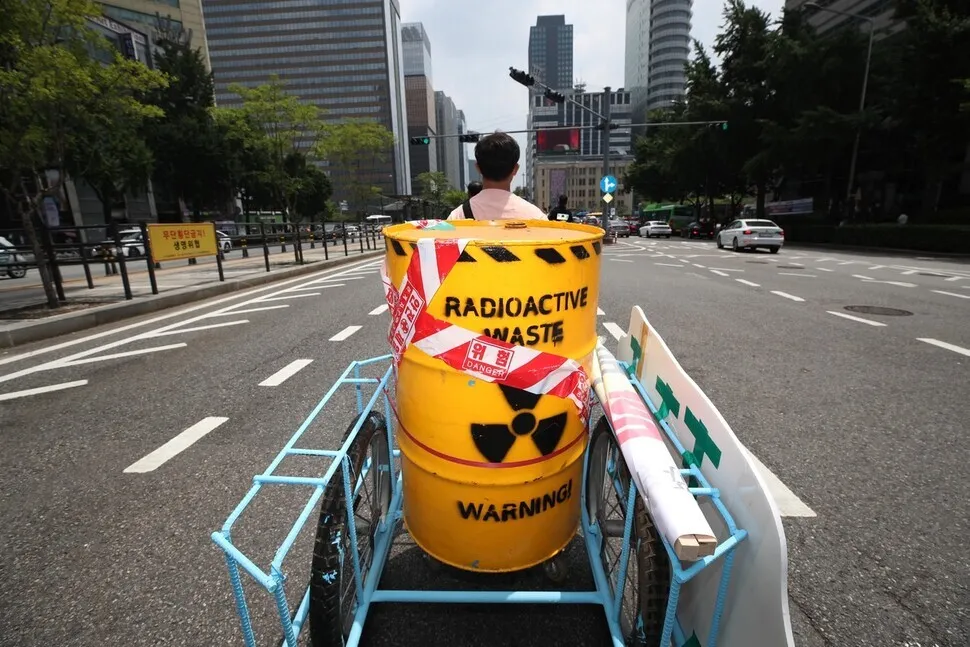hankyoreh
Links to other country sites 다른 나라 사이트 링크
[Column] Japan is flushing its conscience down the drain with the radioactive Fukushima water


By Jeong Nam-ku, editorial writer
Once, an acquaintance told me about a time he asked someone smoking inside the office near him to put their cigarette out. This is how that person responded.
“Me smoking one pack of cigarettes here isn’t going to give you cancer.”
Japan, in its insistence on dumping radioactively contaminated water from the Fukushima nuclear plant into the sea, shares the same mindset as that smoker.
Japan will push ahead with the discharge of the contaminated water sooner or later, and the day it finally does pull the lever, it’ll send its conscience down the drain along with the contaminated water.
The Fukushima nuclear meltdown that happened in March 2011 is still ongoing. Nuclear fuel contained in 1,496 fuel rods in Reactors 1 through 3 of the plant partially burned, trapping cesium and other fission products in the reactors, which copiously leaked into the atmosphere when the reactors were damaged.
Much of it was carried away by the wind and scattered around the world.
Melted nuclear fuel debris in the reactor is contaminating groundwater. At one point, highly contaminated water flowed into the ocean at a rate of 300 tons per day. No one knows the total amount that escaped.
It is likely much higher than the 1983 spill of radioactive wastewater from the Windscale Piles, a nuclear reprocessing facility in the United Kingdom, which caused the largest radioactive contamination of the seas in history.
Off the coast of Fukushima, saltwater fish heavily contaminated with cesium, which has a long half-life, continue to be caught.
TEPCO, the national power corporation, has been scooping up and storing the contaminated water in tanks. It is said to be filtering cesium and strontium from the contaminated water using the SARRY (“simplified active water retrieve and recovery”) adsorption system, and then using the Advanced Liquid Processing System (ALPS) to filter other controlled nuclides, such as tritium, below the permissible threshold for discharge.
Putting aside the fact that it contains an average of one-fortieth of the carbon-14Y threshold, contaminated water that fails to filter out any tritium is still radioactive waste from a meltdown. Dumping it back into the ocean is to expose humanity to great harm from the nuclear meltdown and to abdicate responsibility for doing so.
The contaminated water contains an average of 680,000 becquerels of tritium per liter. (A becquerel is the quantity of radiation released by the decay of one atomic nucleus in one second).
This is more than 10 times the Japanese limit of 60,000 becquerels per liter. The International Commission on Radiological Protection (ICRP) recommends that radiation exposure to the public be reduced to 1 millisievert per year or less, based on the principle of “As Low as Reasonably Achievable,” taking into account social and economic factors.
60,000 becquerels per liter is a concentration of radioactivity that would result in an exposure close to 1 millisievert if you drank 1 ton of water containing it over a year.
One millisievert is thought to be the level of radiation at which 1 in 10,000 people die of cancer. It’s a number that says, “I’m willing to take that risk,” similar to traffic fatality rates. But it’s not a guarantee of safety.
The Japanese government plans to dump the tritium-laden contaminated water by mixing it to a 1:50 ratio with seawater to reduce the concentration to below 1,500 parts per liter.
Diluting the water with seawater is an easy way to bring the initially high concentration of contaminated water below the standard. There are 136 trillion tons of seawater on Earth, enough to dilute the 1.3 million tons of contaminated Fukushima water by one part per trillion.
“It’s okay because it’s below the threshold” is a dangerous sentiment that implies the vastness of the ocean means we’re nowhere near reaching the point where our contamination of it threatens human life.
The Japanese government needs to slam the brakes on its plan to dump irradiated water into the ocean. It may be an economical solution for Japan, but Japan has no right to ask its neighbors to take on the risk for no benefit.
In Korea, President Yoon Suk-yeol, his government, and the ruling People Power Party are busy giving cover to the Japanese government.
While Yoon is consistent in his statements that “no radiation was leaked from the Fukushima nuclear plant” and “we have to dispense with the bureaucratic penchant for valuing safety,” I sometimes wonder if he realizes he’s the president of South Korea, not Japan.
I myself will continue to eat salt from Korea’s western coast and raw fish from the south, since I believe that the inconvenience of not being able to eat such delicacies outweighs paranoia about the contaminated water.
But when I think about how we’re destroying the ocean, this common asset of ours, I lose all words.
The irradiated Fukushima water contains 900 trillion becquerels of tritium. Nuclear power plants around the world have been releasing as much as 100 trillion becquerels of tritium per year.
Nuclear reprocessing facilities in the UK, France and Japan emit many times more tritium than nuclear power plants. Heavy metals, chemicals, and microplastic pollution are worse than radiation.
These atrocities happen despite the fact that the ocean is where all life began.
Please direct questions or comments to [english@hani.co.kr]

Editorial・opinion
![[Column] Chaebol can’t take credit for KOSPI’s record rally [Column] Chaebol can’t take credit for KOSPI’s record rally](https://flexible.img.hani.co.kr/flexible/normal/500/300/imgdb/original/2025/1009/7717599742966572.jpg) [Column] Chaebol can’t take credit for KOSPI’s record rally
[Column] Chaebol can’t take credit for KOSPI’s record rally![[Column] Solving the dilemma of OPCON transfer and inter-Korean relations [Column] Solving the dilemma of OPCON transfer and inter-Korean relations](https://flexible.img.hani.co.kr/flexible/normal/500/300/imgdb/original/2025/1008/7017598865521297.jpg) [Column] Solving the dilemma of OPCON transfer and inter-Korean relations
[Column] Solving the dilemma of OPCON transfer and inter-Korean relations- [Column] Korea, don’t trust and don’t be fooled
- [Column] Understanding what the US means by ‘modernizing’ its alliance with Korea
- [Editorial] Judge’s conduct undermines confidence in Yoon’s insurrection trial
- [Editorial] Government negligence comes under scrutiny after Korean data center fire
- [Column] Trump at the UN: The braggadocio of evil
- [Editorial] Disruptions to government systems raises questions about Korea’s status as IT powerhouse
- [Column] There’s no compromising on ending the insurrection
- [Column] America is marching toward fascism
Most viewed articles
- 1[Column] Solving the dilemma of OPCON transfer and inter-Korean relations
- 2Europe looks to citizens’ assemblies to help tackle contentious issues
- 3How Taiwan uses digital democracy to fight AI misinfo and foster social dialogue
- 4[Column] Chaebol can’t take credit for KOSPI’s record rally
- 5Citizens hold “spirit marriages” to honor victims of Gwangju Massacre
- 6Prosecutors ask to leave special counsel team in protest of service’s abolition
- 7[Column] Korea, don’t trust and don’t be fooled
- 8Former bodyguard’s dark tale of marriage to Samsung royalty
- 9Koreans are getting taller, but half of Korean men are now considered obese
- 10Poet Kim Hye-soon wins US National Book Critics Circle Award, a first for a Korean writer